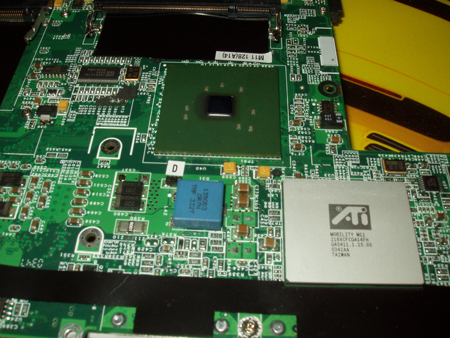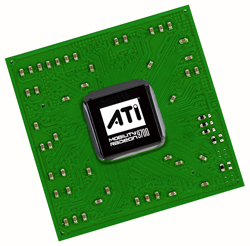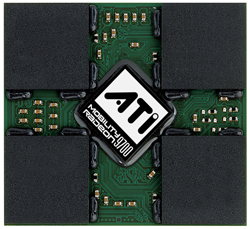ATI's Mobility Radeon 9700 - What's in a name?
by Andrew Ku on February 3, 2004 12:50 AM EST- Posted in
- Laptops
ATI Mobility Radeon 9700 - All the details
As you no doubt expect, the Mobility Radeon 9700 is based on the R360 architecture; its desktop brother being the Radeon 9600 XT. So, like we mentioned in our mobile GPU Q1/2004 update, ATI wasn't going to use the "Mobility Radeon 9600 XT" naming derivative for the M11, a decision that was settled some time ago. Based on the R360 core, M11 is manufactured on a low-k dielectric 0.13-micron process, which makes it the first mobile GPU of this nature.The benefits of a low-k dielectric are mainly related to shielding from crosstalk in high transistor density chips. The benefit of a low-k process is mainly the ability to scale up clock speeds while maintaining low power consumption and low thermal emissions. The latter reasons provide a big selling point to system manufacturers. Assuming that the M11 has an increase in performance over M10, it proves to be a very tempting solution, since it has no noticeable increase in the operating voltage and power consumption spec from the M10.
There are no specific "official" clocks for the Mobility Radeon 9700, for the reasons we explained in our mobile GPU Q1/2004 update. However, ATI tells us that their customers are going to implement the Mobility Radeon 9700 with core clocks in the range of 390MHz to 450MHz, while the memory clocks will run in the range of 200MHz to 260MHz. One of the big design wins for ATI runs slightly above the memory range, which ATI is more or less mandating to their customers. This suggests that the aim for ATI in core clock will remain 450MHz, while the memory clock is something like 275MHz, since ATI and NVIDIA traditionally announce "official" clocks that are in 25MHz derivatives.

(Click to enlarge.)
Our experience with notebooks has been that the M10 GPU can run effectively with passive or minimal active cooling designs. Meanwhile, the M11 GPU needs a more extensive passive cooling design (i.e. a larger heatpipe) or a small heatsink fan. This seems to be the reason why ATI is utilizing an integrated heat spreader on some of its chips.
As far as naming is concerned, you are probably scratching your head on ATI's choice of Mobility Radeon 9700. After all, the Radeon 9700 Pro (R300) has eight rendering pipelines, while the Mobility Radeon 9700 has four. The 9700 designation for the M11, though, is mainly to due to the Mobility Radeon 9600 and desktop "XT" designations. ATI has, thus far, reserved the use of the post-fix "XT" for desktop cards that support OverDrive, and the fact that the majority of laptops weren't going to implement OverDrive wasn't going to play to ATI's benefit. Prospective notebooks would just be puzzled in the end due to the lack of the feature, which couldn't be enabled by the end user because the system vendor would choose to disable the hardware component that supports the OverDrive capability.
Making things a bit more complicated, the Mobility Radeon 9600 name has been stretched much further than originally planned. The Mobility Radeon 9600 Pro was supposed to feature GDDR2-M and OverDrive, but due to the cancellation of the memory by Elphida, the Pro version was just a slightly higher clocked version of the non-Pro. The addition of the Turbo Pro threw a monkey wrench into the mix by creating a three-tier Mobility Radeon 9600 family.
Dubbing the M11 as Mobility Radeon 9600 XT would create a nice middle class suburbanite family of four. Because M11 is called "M11" and not "M10.5", ATI wants to emphasize that it is a generation jump, and using the 9600 obviously wouldn't create that impression (aside from the obvious conclusion that you would draw about its performance). Naming it "Mobility Radeon 9800" would no doubt be a stretch, so Mobility Radeon 9700 came as the most obvious solution. This is more of a lack of options due to unforeseen repercussions because of the Mobility Radeon 9600 three-tier naming mess. The question is then, "does the M11 live up to the name ATI has given it?" Of course, we will get to that in a bit.












14 Comments
View All Comments
Platter - Saturday, February 14, 2004 - link
Suppose, just for the sake of argument, that the recent official announcement from IBM regarding the 970FX has something to do with ATI's 'Big One™'?PowerBook G5, anyone?
Andrew Ku - Monday, February 9, 2004 - link
Ok, so to answer some of the inquires posed to me - if you currently own a Mobility Radeon 9600 (one of the three) based notebook, you are more or less set to go. The Mobility Radeon 9700 in the majority of cases behaves like an OC'ed version of its predecessor. However, the M10 is still a very hardy chip seems like it is going to have a long life cycle.As for waiting time, it looks like the bulk of the design wins won't start to be announced until the end of Feb. So go with a M10 based notebook if you plan to buy within the next few months or if you are just looking for the "traditional notebook." It's going to take some time before mainstream sees M11 in their mobile systems. And when it does, M11 will be in DTR notebooks for the most part.
Serp86 - Thursday, February 5, 2004 - link
i think that the performance difference is quite enoght to justify calling it a 9700.yomer - Thursday, February 5, 2004 - link
So Andrew, Dell is supposed to be one of the bunch in adopting the M9700. Might Dell be called BIG? I wanted to buy an IBM t41p with a mobility firegl T2(based on the 9600) with 128MB. Should I wait and buy a notebook with the new M9700? Is it worth it? How much should we wait in oder to be able to buy one of thoes notebooks here in the US?TrogdorJW - Wednesday, February 4, 2004 - link
#9, it's all marketing. There will be enough people out there that don't know hardware who will just assume the 9700M is the same as the desktop 9700. Too bad for them. The important thing is that the M11 *is* quite a bit faster than the R9600 Mobility Pro, right? Or maybe they should have called the part the Mobility Radeon 9800 SE? ;)CaptainSpectacular - Tuesday, February 3, 2004 - link
ok ATI, what's with the naming scheme. this is absolutely awful! This part has nothing to do with the desktop 9700. I understand the dilema as presented, but what's wrong with 9650? or some other similar variation? the name 9700 is flat out misleading, regardless of how you justify it. This is almost as bad as nvidia calling the NV17 a GeForce4 series card (ok, not nearly that bad, but same idea...)Slappi - Tuesday, February 3, 2004 - link
Well if it is BIG I would think the biggest notebook maker is Toshiba and they are all Nvidia now so....... that would be huge.Do I get a cookie?
Andrew Ku - Tuesday, February 3, 2004 - link
#6 - Sorry, no hints. You can count all the big guys on a single hand, and so there isn't much point in the old'e guess and check.yomer - Tuesday, February 3, 2004 - link
Andrew please! Tell me that the big name is not IBM!!Andrew Ku - Tuesday, February 3, 2004 - link
#2 - From our talks with the OEMs and ODMs, we understand that the pricing between the two chips is basically pocket change for prospective notebooks owners.